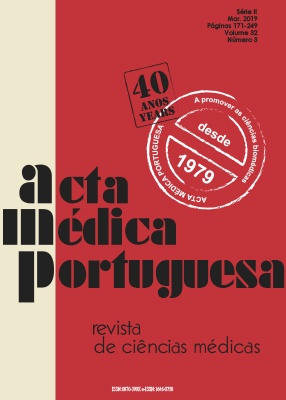Late Ophthalmologic Referral of Anisometropic Amblyopia: A Retrospective Study of Different Amblyopia Subtypes
DOI:
https://doi.org/10.20344/amp.10623Keywords:
Amblyopia/epidemiology, Anisometropia/epidemiologyAbstract
Introduction: Amblyopia requires a timely diagnosis and treatment to attain maximum vision recovery. Specialty literature is lacking on how early amblyopia is referred. We aimed to understand if there are mean age differences at first referral for ophthalmologic tertiary center consultation among non-amblyopic and different types of amblyopia, in a context of lack of population screening.
Material and Methods: In this retrospective model, the sample corresponded to all children born in Braga Hospital during 1997 - 2012 (3 - 18 years-old), with an ophthalmologic consultation in 2014. Data was collected from the clinical records and children were divided in a non-amblyopic versus amblyopic group. The amblyopic group was subdivided in strabismic versus refractive (anisometropic/bilateral).
Results: The sample had a total of 1665 participants, 1369 (82.2%) without amblyopia and 296 (17.8%) with amblyopia. Among amblyopia: 67.9% (n = 201) refractive, 32.1% (n = 95) strabismic. Within refractive amblyopia: 63.7% (n = 128) anisometropic and 36.3% (n = 73) bilateral. The mean age at first consultation was 6.24 ± 3.90 years-old: 6.39 ± 3.98 for non-amblyopic and 5.76 ± 3.58 for amblyopic. Among amblyopia subgroups, there were significant differences in mean age at first consultation (F3,1250 = 8.45; p < 0.001; η2 = 0.020). Strabismic and bilateral refractive amblyopia were referred earlier, when compared to non-amblyopia or anisometropic amblyopia (p < 0.05). Anisometropic amblyopia had the highest first consultation mean age: 6.92 ± 3.57 years-old.
Discussion: Without specific pre-school screening, children with amblyopia were referred to their first ophthalmologic evaluation significantly later than desired, especially anisometropic amblyopia, with a postschool mean age for first consultation.
Conclusion: Recognizing high-risk children is essential for earlier referral and helps minimize future visual handicap.
Downloads
Downloads
Published
How to Cite
Issue
Section
License
All the articles published in the AMP are open access and comply with the requirements of funding agencies or academic institutions. The AMP is governed by the terms of the Creative Commons ‘Attribution – Non-Commercial Use - (CC-BY-NC)’ license, regarding the use by third parties.
It is the author’s responsibility to obtain approval for the reproduction of figures, tables, etc. from other publications.
Upon acceptance of an article for publication, the authors will be asked to complete the ICMJE “Copyright Liability and Copyright Sharing Statement “(http://www.actamedicaportuguesa.com/info/AMP-NormasPublicacao.pdf) and the “Declaration of Potential Conflicts of Interest” (http:// www.icmje.org/conflicts-of-interest). An e-mail will be sent to the corresponding author to acknowledge receipt of the manuscript.
After publication, the authors are authorised to make their articles available in repositories of their institutions of origin, as long as they always mention where they were published and according to the Creative Commons license.









